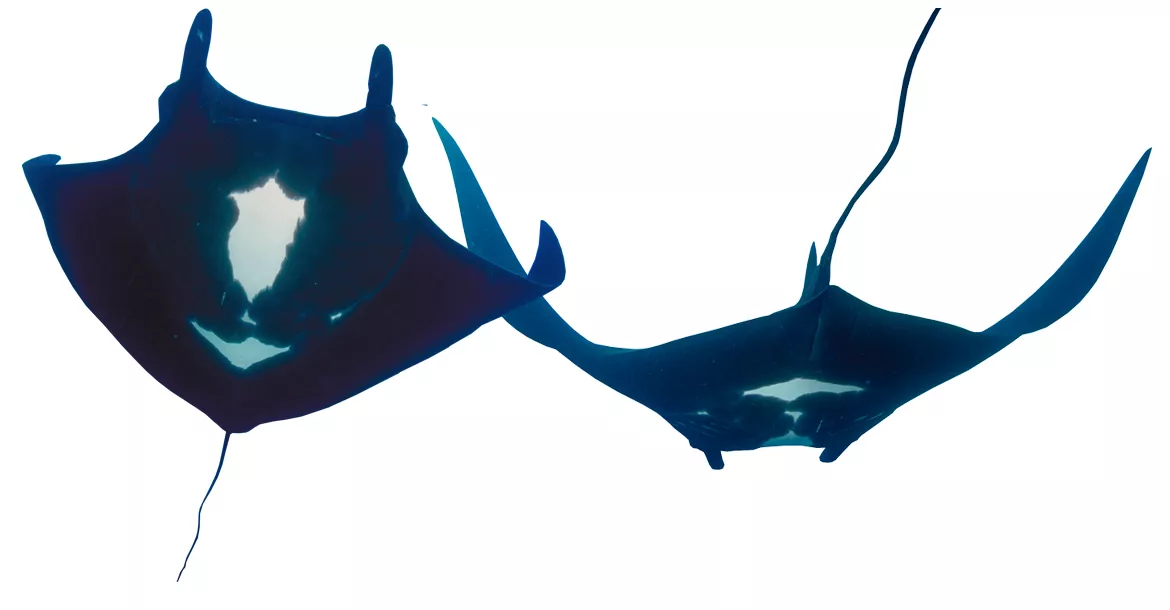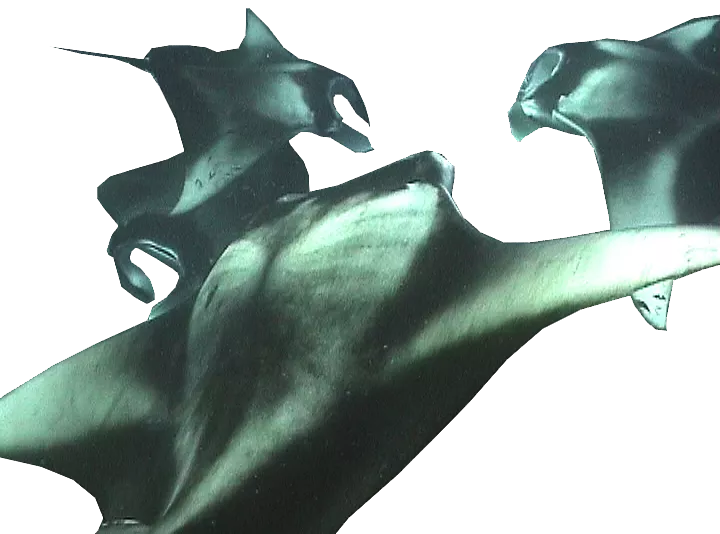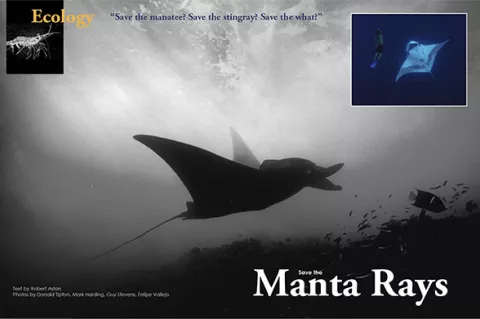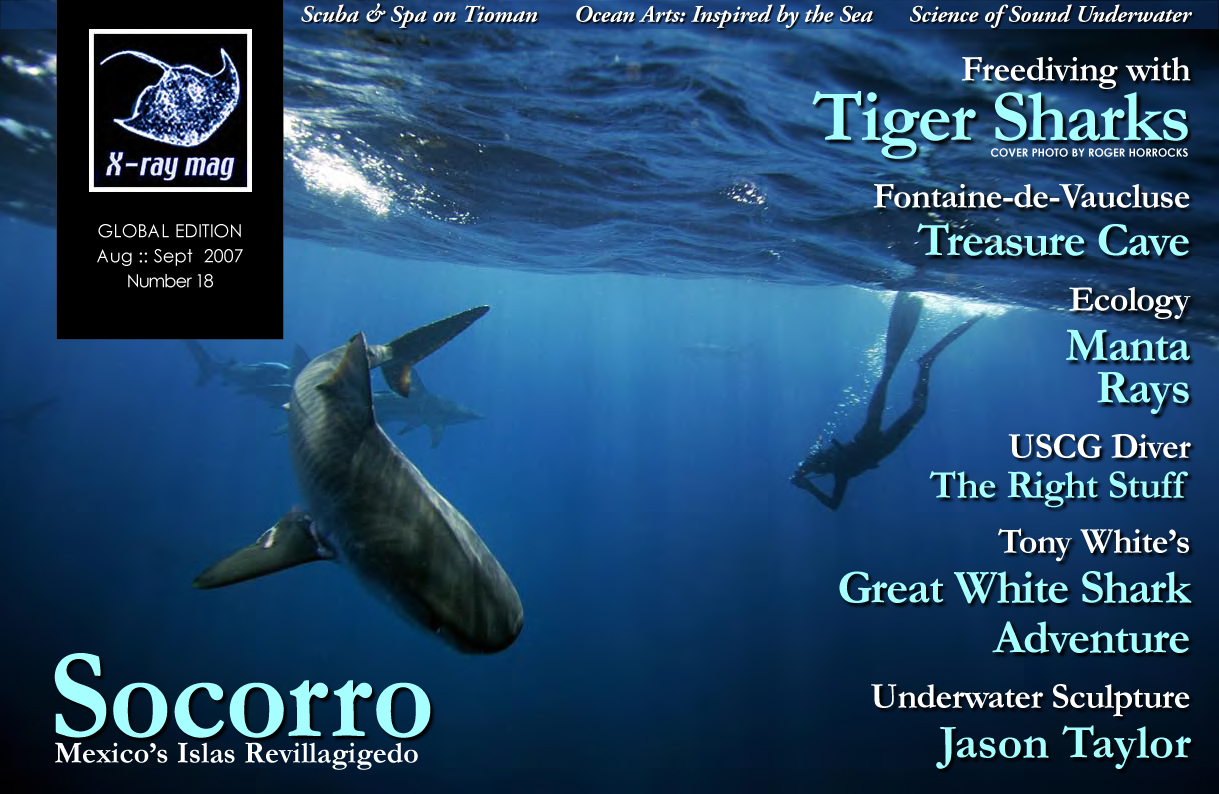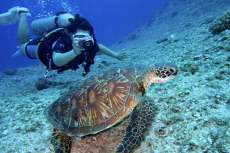If you ask a group of people what is a manta, nine out of ten will think of stingrays or those large things that swim in the rivers of Florida. Even through the manta ray is the largest winged creature on the planet and has a wingspan wider than a condor, few people even know they exist. The width of a manta ray can exceed 22 feet. They are part of the shark family but hold no danger to humans as they eat only tiny zooplankton. They are found throughout tropical and subtropical regions of the world. In the Pacific Ocean, they have been documented as far south as New Zealand and as far north as Hawaii.
Contributed by
“Save the manatee?
Save the stingray?
Save the what?”
If you ask a group of people what is a manta, nine out of ten will think of stingrays or those large things that swim in the rivers of Florida. Even through the manta ray is the largest winged creature on the planet and has a wingspan wider than a condor, few people even know they exist.
The width of a manta ray can exceed 22 feet. They are part of the shark family but hold no danger to humans as they eat only tiny zooplankton. They are found throughout tropical and subtropical regions of the world. In the Pacific Ocean, they have been documented as far south as New Zealand and as far north as Hawaii.
Even though they can be observed far from shore, they are mainly seen in small groups around the islands of Micronesia, French Polynesia and Indonesia. In the Indian Ocean, the population around a single atoll in the Maldives may number in the thousands. Off the coast of eastern Africa there is anecdotal evidence of the world’s largest manta rays. We do not know why they live only in certain areas. We suspect their habitat preferences may be tied to certain periods of their lifecycle with open water migration only occurring for the more mature individuals within a given population.
Manta rays are slow to reproduce with one or two pups per year, slow growth rates and late age of first reproduction. Information on maturity and their presumed long generation time of more than fifty years has not been fully documented. A recorded instance of small population size with minimal exchange between areas indicates an enhanced risk for local extinction.
Manta rays are not well-known for several reasons. Being solitary animals, humans have had little contact with them. Until recently, not much was known about them so they were feared and called “devil rays” due to the two fins on their heads that resemble horns. The name “manta” comes from the Portuguese word for blanket. They were thought to have attacked and capsized small fishing boats.
Many fishermen and islanders considered them monsters from the sea.
Featured in the 1945 movie “Fish From Hell”, fishermen in the Sea of Cortez feared that the giant manta would eat all their fish. This could not be further from the truth as mantas and mobula rays are plankton eaters and hold no threat to fish, let alone humans.
Fifty years later, I found myself heading south of Cabo San Lucas, Mexico bound for a remote area of the Eastern Pacific and home to a rich assortment of marine pelagic life. I was on an assignment for a popular dive magazine but little did I know what would be in store for me as I covered the diving surrounding Socorro and San Benedicto Islands. (see preceeding article in this issue).
From my first encounter with a 16-foot wide manta ray, I was entranced. Day after day we played, often with several rays at arm’s reach. At times they passed overhead blanketing the sun’s rays. On our last day we were treated to a full day of frolic in the mantas’ playground.
Dive after dive I was joined by four large mantas that circled in the warm, clear waters just off the seamount. As I recounted in my 1995 article, Socorro Islands--The Manta Playground, “I waited motionless, two mantas glided above and two below. Without fear, one large manta with two white spots on its back circled ever closer. As she came to rest four inches from my face, our eyes met again. We were both motionless as we each contemplated the other’s being.
None of us that played with the mantas that day will ever be the same again.” At that time I had no idea that for the rest of my life I would be on a quest to save the world’s mantas.
While on that trip, I learned that in early 1994 two Mexican fishing boats had violated the marine sanctuary, killing two large manta rays as part of their normal netting operation. This deadly deed was recorded on video by passing sport divers. The fishermen even allowed the videographer on board to record the full impact of the event.
The fishermen had not realized that the videotape would quickly be conveyed to the Mexican officials in Cabo San Lucas where it would get immediate media attention. Fortunately, this led to even stricter government permits, regulations and a step up in the monitoring and inspections.
A year later, I formed an alliance with Dr. Bob Rubin, a foremost authority on Manta birostris. After my second trip to research the Socorro mantas, we decided that a global manta conservation organization was needed. It took a while to organize and The Manta Network was granted non-profit status in the fall of 2004.
The first answer to that question is that little, none or bad press exists surrounding mantas. The second reason is the lack of data from fisheries, scientific and international trade sources.
Occasionally, mantas are included in some sensational press coverage such as the 1997 newspaper article “Everything Killed in the Trap Net Fishery”. Highly illegal fishing practices known as “Trap Nets” were installed in 1996 by a Taiwanese fishing fleet in a pelagic migratory channel at Manado, Indonesia.
This article states: “Between 27 March 1996 and 12 February 1997 the catches included some 1,424 manta rays, 18 whale sharks, 312 other sharks, 4 minke whales, 326 dolphins, 577 pilot whales, 789 marlin, 84 turtles, and 9 dugong.” The fishermen reported all of these as “by-catch” (non-intended species) but most of the animals were frozen and sent to market.
Consumption
Little is known about the world consumption of mantas due to inaccurate or non-existent reporting. Manta ray catches are generally grouped with other rays in by-catch reports making them of little conservation value. CITES (the Convention on International Trade in Endangered Species of Wild Fauna and Flora) is an international organization that was formed by a treaty with 172 member states to monitor and regulate international trade. Mantas and mobula rays have yet to be added to the list requiring fishery monitoring.
An obscure record of exit declarations by Chilean micro exporters to South Korea in 2005 reported that manta rays yielded nearly three times more revenue than corrugated paper exports, some US $106,000. This was slightly up from the previous year and nearly twice that of eel exports.
In May of 2002, while doing work with WWF in the remote Alor region of eastern Indonesia, Dr. Heidi Dewar found that a single village had converted its previous local consumption of mantas into a commercial venture. Mantas were hunted and their skin sent to Jakarta where it is used in the production of shoes and wallets.
The dried manta gill plates are sent to Hong Kong where they are used in traditional medicines. Dr. Dewar estimated that the total take over an average season was in excess of 1,500 mantas. She feared that this number could not be sustained and with villagers now buying motorboats with longer ranges, other areas would be affected, especially the nearby Komodo Marine Sanctuary.
In another part of the world off the coast of Tanzania, local fishermen are dynamiting the reef as this makes it easier to catch a diminishing fish supply. Manta rays, as well as most marine animals, rely on smaller fish to perform parasite removal from their skin. Manta cleaning stations perform a vital service in keeping the population healthy. Destruction of the coral reef and the cleaning stations render the mantas in jeopardy of contracting skin diseases which compromises their health.
It is difficult enough to obtain data on legal fishing and almost impossible to find out about illegal activities. This problem has thwarted our efforts to submit a petition to CITES for the protection of manta rays. It will be another three years before they will convene and by then it may be too late to begin the data collection, so we must act now.
Since the late 1990s, efforts to protect manta rays have begun in several locations where manta frequent. One of the earliest efforts began in Kona, Hawaii with Manta Pacific, a non-profit volunteer group. Over several years, the local population was photographed and recorded in attempts to provide data for their protection. Studies have indicated that protection of mantas are not only good for the mantas but also for manta tourism which has contributed more than $2.5 million a year to the local economy.
In the last two years, several more organizations have been formed, some for research and others for conservation. (See “Mantas From Around the World”) Most of these have small budgets, are staffed by volunteers and focus only on local populations and issues. As part of the shark family, mantas have been included in some of the programs headed by global conservation organizations.
The Manta Network is the only global organization dedicated solely on manta and mobula rays. It is working to create programs to protect and conserve mantas. Its mission is to create a knowledge base to educate fishing and tourism industries, government organizations, conservation groups and the public on the importance of protecting and conserving these magnificent creatures.
The Manta Network’s efforts are focused into scientific research, education, conservation and protection. Studies are conducted in conjunction with leading manta researchers. It strives to make available accurate information about areas where manta populations are threatened that helps to increase industry, government and public awareness about the critical issues.
The Manta Network combines scientific research with education and community to foster conservation and protection. The organization serves as a central repository for manta information and a resource for any organization or individual seeking to further their work.
A network of volunteers has been created to provide research on manta behavior and habit preferences. The manta advisory board consists of many leading manta biologists. They work with other researchers, sport scuba divers, photographers, dive and tour operators and concerned individuals in more than twenty countries around the globe.
Working with affiliates, scientists and other conservation organizations, a global database is being built. Photographic identification techniques are being employed to collect data on individuals. Work has begun on the development of an automated ID process that will help to build the database more quickly and accurately. This data is being used to help scientists understand manta behavior, population dynamics, habitat preferences and migration behavior.
Research goals include obtaining and funding critical manta projects that take scientists into the field and allow concerned individuals to participate through research expeditions. When possible, funding supports organizations undertaking important local research.
Education plays an important role and involves members, volunteers, research affiliates, researchers, educators, schools and supporters. The website employs innovative, state-of-the-art custom software to create a “global virtual community.”
One innovative program involves the creation of an Internet-based network of live underwater video cameras. Situated at high-profile manta cleaning stations and feeding areas around the world, live camera feeds of mantas will be made available to classrooms around the world.
Oceanario Aquarium in Lisbon, Portugal is one of only three aquariums in the world that house live manta rays. A MantaCam is soon to be operational allowing people and classrooms to view the swimming manta on a daily basis.
Threatened
Recently added to the “Threatened Species List,” Manta birostris is now the focus of marine research intended to support the claim that they are endangered. A significant amount of data needs to be collected to establish their importance within the ocean’s ecosystem. Information on fisheries, by-catch, poaching and international trade is crucial to their protection and effective conservation management.
Susceptibility to increased predation, loss of habitat and accidental by-catch is increasing the risk of extinction. This vulnerability is affecting several documented local populations. Some scientists conclude that the pressure on the local populations will lead to local extinction and may result in long-term reduction or extinction of the global population.
Several reports conclude that more than 90% of the world’s pelagic fish have disappeared due to excessive harvesting and illegal fishing practices. These include shark finning for shark fin soup which is a Chinese delicacy, even through the fins have no taste. Scientific circles fear that global warming will dramatically affect coral reefs and along with them the manta cleaning stations, destroying in a few years what took millions of years to create.
Loss of manta cleaning stations along with the fish that service them will have a significant impact on the world’s manta rays. It is a threatened species that could very well be in danger of extinction.
We need to act quickly to raise awareness of the plight of the global population of manta rays and the urgent need to protect them. If we hesitate, the world’s largest winged and most majestic creature will be gone before most people ever knew they even existed.

